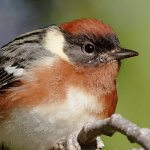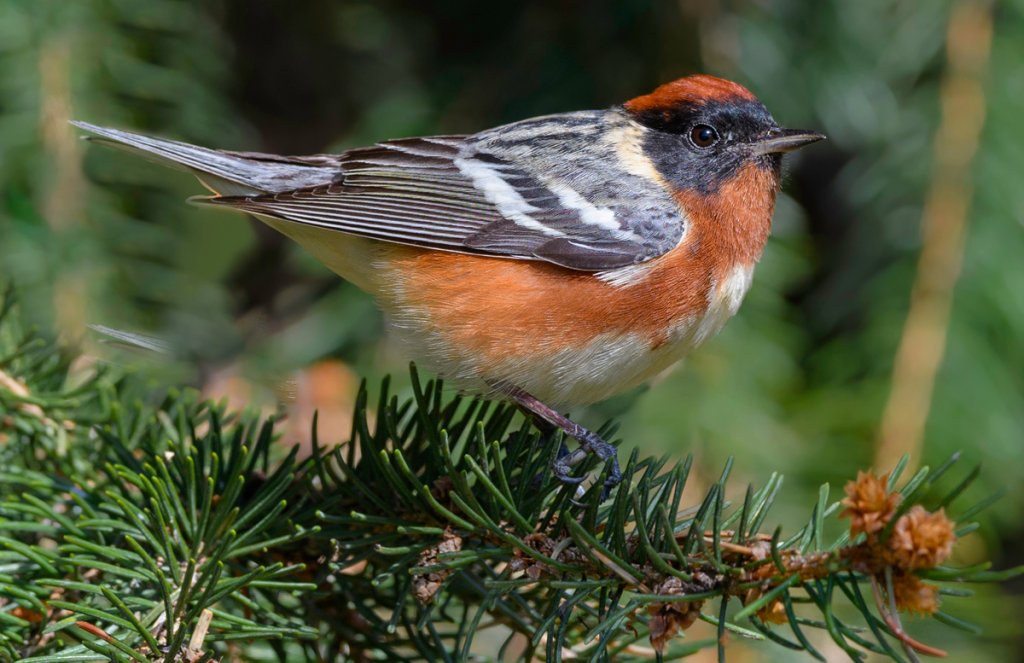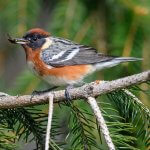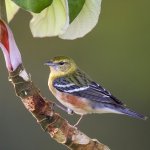
The adult male Bay-breasted Warbler is unmistakable, with its black face and chestnut head. However, the species falls into the “confusing fall warblers” category, with nonbreeding males, females, and juveniles closely resembling their counterpart Blackpoll or Pine Warblers.
Bay-breasted Warblers feast on eastern spruce budworm, a native but often destructive insect. The two species are so closely tied that budworm outbreaks (or declines) affect the warbler's population. Bay-breasted Warbler's overall population has dropped about 74 percent since 1966, likely due in part to use of pesticides to control the budworm.
The Bird and the Budworm
Other boreal-nesting birds, such as the Magnolia Warbler, also increase in population during years of spruce budworm outbreaks; the excess of food means the warblers are able to produce more young. (Birds other than warblers, including the Evening Grosbeak, also exploit the periodic abundance of budworms.)
During outbreaks, Bay-breasted Warblers together consume thousands of these caterpillars every day. This natural pest control can actually help reduce the frequency of the damaging outbreaks.
Breeding in the Boreal Forest
Canada's boreal forest provides almost all of this bird's breeding range. (Here, and on its wintering grounds in Costa Rica, Panama, and northern South America, habitat loss is another factor contributing to the species' decline.)
For nesting, the birds prefer mature, dense, boreal spruce-fir forest stands near water. Males are solitary and highly territorial.
Females primarily build the cup-shaped nest, usually in a dense conifer on a low branch. Typically, she lays five eggs; clutch size may be larger in years of plentiful food supply. The female alone incubates the eggs.
Switching Continents (and Diets)
Many migratory birds that switch between North America and the tropics switch their diet according to the season. Bay-breasted Warblers are no exception. In summer, in addition to spruce budworms, the warblers eat tent caterpillars and spiders.
The species' winter diet is mixed, focusing on insects when they are plentiful and shifting to small fruits during the dry season. Bay-breasted Warbler is more gregarious on its wintering grounds than in the breeding season.

Wintering birds forage in mixed flocks with resident birds and other migrants, including Tennessee and Chestnut-sided Warblers. Cerulean and Kentucky Warblers are among the other migratory birds using winter similar habitat.
Bay-breasted x Blackpoll
The Bay-breasted Warbler is closely related to the Blackpoll Warbler; sometimes, hybrids between the two species occur. The Bay-breasted Warbler is also known to hybridize with Yellow-rumped and Blackburnian Warblers.
The Bay-breasted nests and forages in much the same way as the Blackpoll Warbler, but the two species seem to avoid competition by nesting at different tree heights; the Blackpoll tends to nest higher.
Bringing Back the Birds

Help support ABC's conservation mission!
Although still numerous, the North American Breeding Bird Survey shows that Bay-breasted Warbler populations are declining over much of their range. The species is on the Partners in Flight Watch List in the category of moderately abundant or widespread, but with declines or high threats. Bay-breasted Warbler shows similar declines in Canada.
Canada has taken steps to protect large areas of boreal forest, preserving millions of acres of habitat for the Bay-breasted Warbler and other species dependent on these areas, including Canada Warbler, Swainson's Thrush, and Olive-sided Flycatcher.
Through our large-scale effort to “bring back the birds,” ABC and partners are protecting habitat north, south, and in-between for migratory birds. For example, with our support, Bay-breasted Warbler habitat is protected by ProAves in Colombia's El Dorado Reserve.
Donate to support ABC's conservation mission!






















































